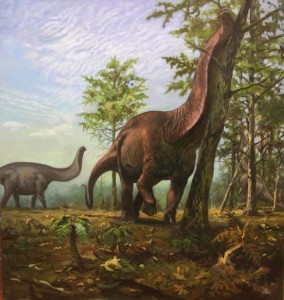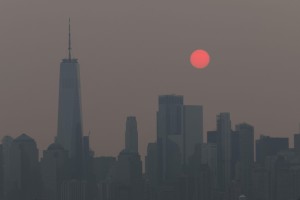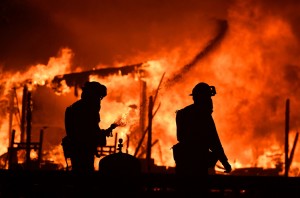Global Heat Wave Hits the West
Tuesday, September 6th, 2022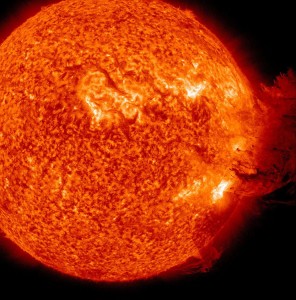
The sun produces heat from nuclear reactions deep inside it. All life on Earth depends on this heat.
Credit: NASA/SDO
This summer, the entire globe experienced a heat wave. Western states in America experienced a record-breaking heat wave in late August and early September of 2022.
A heat wave is a period over which the temperature rises well above normal for a particular region. Heat waves may be less dramatic than such natural disasters as hurricanes, earthquakes, or tornadoes, and heat waves tend to cause less damage to property. However, heat waves rank among the deadliest extreme weather.
The varying nature of local climate makes it difficult to establish a simple definition of a heat wave. The temperatures of a heat wave must be hot relative to the average temperatures at a place during a particular time of year. For example, a temperature of 90 °F (32 °C) during the summer is not out of the ordinary for the northern African country of Sudan. However, it would be an exceptionally high temperature for the northern U.S. state of Alaska. Meteorologists agree that high temperatures must persist for more than one full day to be considered a heat wave.
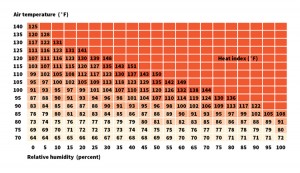
This chart can be used to determine the heat index (HI), a number that describes how people are affected by the combination of temperature and relative humidity. As the temperature and relative humidity rise, the heat index increases. The higher the index, the greater the likelihood that people will develop heat-related illnesses. The risk of illness is low when the index is below 80 °F.
Credit: World Book chart by Linda Kinnaman
Heat waves are sometimes accompanied by high relative humidity. Relative humidity is the amount of water vapor in the air compared with the amount the air can hold at saturation. High relative humidity interferes with the human body’s ability to cool itself through the evaporation of sweat. Thus, high humidity can make a heat wave more uncomfortable and dangerous. Some weather agencies make use of a measure called the heat index, which factors in relative humidity to give a measure of how hot the air feels.
Heat waves are generally created by areas of high air pressure. Meteorologists call these areas highs or anticyclones. Warm highs bring high temperatures and air that contains little moisture. These highs are large weather systems that may affect a region for an extended time. In the summer, a warm high sometimes stalls over North America, for example, causing a heat wave.
The high temperatures of a heat wave can cause dehydration and hyperthermia in people and in animals. Dehydration is a condition in which the body loses too much water. In severe cases, dehydration can lead to a fast heartbeat, low blood pressure, shock, and death. Hyperthermia is a condition that occurs when the body becomes overheated. Forms of hyperthermia include heat exhaustion, heat cramps, and heatstroke (also called sunstroke). Heatstroke is a serious condition that can cause permanent neurological damage and death.
Elderly people, infants, and people with long-term illnesses may suffer heatstroke more readily than others during a heat wave. Hyperthermia can be particularly dangerous for people with long-term medical conditions. Such conditions as asthma, diabetes, heart failure, and high blood pressure place the body’s organs under stress. The added stress from hyperthermia can induce heart attack, breathing failure, and other fatal medical events among such people.
The complexity of diagnosing heat-related deaths has made it difficult for experts to track the toll of heat waves. The World Health Organization estimated that heat waves killed more than 166,000 people between 1998 and 2017. Another study found that approximately 500,000 heat-related deaths occurred worldwide between 2000 and 2019. Despite the uncertainties, experts agree that heat waves are deadly. In 2003, for example, Europe suffered a catastrophic heat wave in which some 70,000 people died.
Heat waves can also put stress on electric power and water services. People’s use of air conditioning strains the electrical grid. Power plants may need more water for cooling. People may also use more water to try to keep cool. When demand for electricity exceeds generating capacity, officials may have to reduce voltage to prevent a blackout. Such a reduction, called a brownout, may damage electrical equipment or cause the equipment to operate less efficiently. High temperatures also buckle pavement and warp railroad tracks.
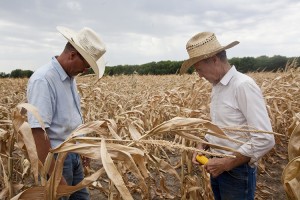
Drought kills crops. Two farmers examine a Kansas corn field that has been affected by a drought in 2012. Climate scientists suspect such droughts might become more common in some areas due to the effects of global warming.
Credit: © Mashid Mohadjerin, The New York Times/Redux Pictures
Heat waves are dangerous to plants and animals as well. Excessive temperatures can kill animals that cannot find ways to keep cool. Prolonged heat can wither plants. Droughts usually accompany heat waves, compounding the danger to living things. Heat waves and droughts dry out the ground and plants, increasing the likelihood and severity of wildfires.
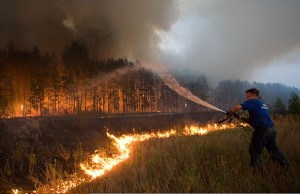
A Russian firefighter sprays water on a wildfire in the Ryazan region, southeast of Moscow. In 2010, a devastating wave of wildfires wept across Russia following a record-setting heat wave.
Credit: AP Photo
Data suggest that heat waves are increasing in duration, frequency, and intensity. The time of year in which heat waves occur is also expanding. Most climatologists think that climate change brought about by human-caused global warming is driving these changes.
People must exercise caution during heat waves to avoid health problems. Experts advise wearing light-colored, loose-fitting clothing when outdoors and avoiding going out during the hottest part of the day. People should drink fluids regularly but avoid beverages with alcohol or caffeine, which can contribute to dehydration.
People who are homeless or who live in homes without air conditioning are particularly vulnerable to heat waves. During a heat wave, local governments may open air-conditioned cooling centers where people can stay to cool down.
People can help to protect their community during a heat wave. They can air condition their homes only to what temperature is necessary, conserving power. People might be asked to limit water use at certain times to prevent drops in their community’s water pressure. They may be asked to conserve water if the heat wave is accompanied by a drought. Because heat waves increase the risk of wildfires, people may be prohibited from starting fires outdoors.

